
Grevillea: planting, pruning and care
Contents
Grevilleas, in a nutshell
- Grevilleas are evergreen bushes easy to grow in a mild climate, even dry in summer, in light, lime-free soil.
- They have slightly prickly, needle-shaped or delicately divided, fern-like foliage, studded with delicate, exotic-looking flowers.
- They are used in borders, hedges, rockeries for creeping forms, in pots (a good alternative) and are pruned from time to time to thicken the clump.
- These evergreen-leaved plants also display a diversity of habits, sizes and colours.
A word from our expert
Grevillea are ornamental bushes or small trees, evergreen and native to Australia. They have a flowering that is very exotic, taking the form of clusters or corymbs of flowers made of curled filaments which lasts from late winter to autumn, usually peaking in spring. Flower colour ranges through tones of red, pink, yellow, orange or even white. The best known is Grevillea juniperina or juniper-leaf grevillea, characterised by narrow, needle-shaped leaves and bright red spidery flowers.
Les grévilléas présentent une grande diversité en terme de taille et de port, allant de l’arbuste prostré de 15 cm de hauteur (Grevillea lanigera Mount Tamboritha) au petit arbre dépassant 10 m dans son habitat mais souvent limité à 2 m de hauteur en culture. Leur feuillage prend une allure tantôt de frondes de fougères, tantôt d’aiguilles de pins plus ou moins épaisses. Leur longue floraison, abondante et singulière, se compose de petites fleurs sans pétales à pistils saillants, réunies en inflorescences terminales qui prendront selon le cas une disposition en araignée, en ombelle, une forme globuleuse, cylindrique ou de “brosse à dents”.
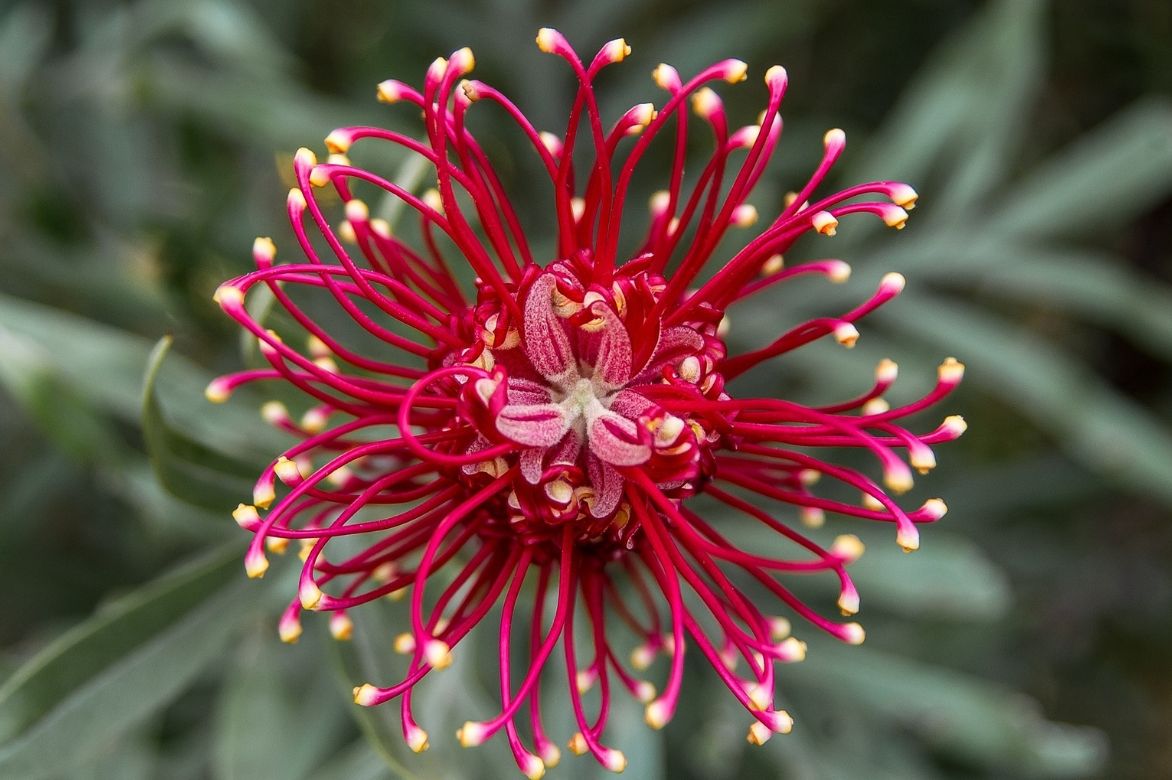
Grevillea, like many other Australian plants, is not difficult to to grow provided conditions are suitable. These cousins of Protea are semi-hardy plants of poor, free-draining, non-calcareous and fairly dry soils, which thrive in open ground in mild climates and are easy to grow in pots elsewhere. Hardiest among them is probably Grevillea rosmarinifolia, able to withstand short frosts down to around -15°C in very well-drained soil.
This Australian bush requires little maintenance and tolerates light pruning which keeps it compact and dense. Plant it without hesitation in coastal gardens spared from severe frosts where, depending on variety, it will form dense, flowering screening hedges for a very long period or a superb cushion on a bank or in rockery for the lowest species and varieties. It is a good plant for dry gardens, requiring an exposed, sunny position. Growing in a container allows both control of growing medium composition and overwintering the bush in an unheated greenhouse or a very bright, lightly heated conservatory.
Description and botany
Botanical data
- Latin name Grevillea
- Family Proteaceae
- Common name Grevillea
- Flowering between February and October
- Height between 0.15 and 35 m
- Sun exposure sun
- Soil type poor, generally acidic and well-drained
- Hardiness rather low (-5 to -15°C)
Genus Grevillea comprises nearly 250 species of trees or bushes, sometimes creeping, with very variable evergreen foliage. It belongs to family of Proteaceae very present in South Africa and which includes notably genera Protea, Banksia, Hakea, Telopea, Leucodendron. Grevilleas are mainly found in Australia with some specimens in New Caledonia and Papua New Guinea. They are pioneer plants, with rapid growth, growing in wooded areas, wet forests and clearings. They tolerate fairly poor dry soils but do not like presence of lime, and require full sun to flower. Size ranges from 30 cm to 35 m in height (G. robusta) with habits from erect tree-like to dense bushy or creeping.
Leaves have a lamina with reduced surface area, either needle-shaped as in Grevillea juniperina or rosmarinifolia, slightly broader with revolute margins in G. olivacea (olive-like leaves), in fern-frond form finely divided (bipinnate) as in Grevillea robusta (15 to 30 cm long) or ‘Robyn Gordon’, or short succulent leaves as in Grevillea lanigera ‘Mount Tamboritha’. Foliage colour ranges from light green to dark green to silvery. In all cases, leaf shows adaptation to drought whether by waxy layer on upper surface, presence of hairs on underside, succulence, etc.
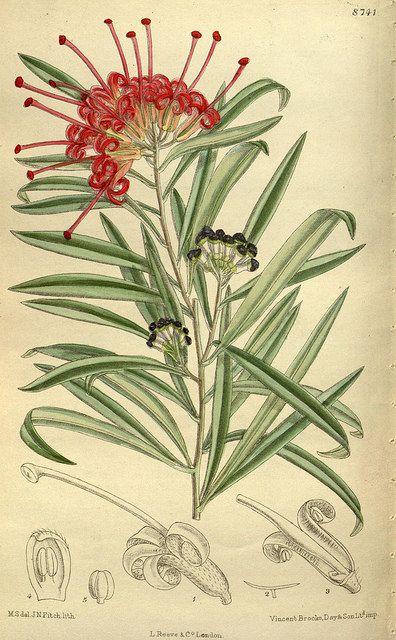
Grevillea oleoides – botanical illustration
Grevilleas generally produce abundant, very exotic-looking flowering due to its arachnid shape, with tepals reduced and rolled like snail shells opening onto 4 stamens at their tip and 1 long protruding pistil curved like a pin before opening. Terminal inflorescences form, in some species such as robusta, unilateral spikes resembling a toothbrush; others are cylindrical and others globular. Flowers sometimes appear directly on the trunk (cauliflory). Flowering offers a whole palette of hues — red, pink, orange, yellow, white. Flowering, highly nectariferous for birds and insects, is a boon as it lasts quite long, often starting in winter followed by an explosion of flowers in spring then a resurgence in autumn. Bushes have very rapid growth and reach adult size within 3 years. Flowering occurs from the second or third year after sowing.
Botanical species produce a lignified, hard fruit that opens at ripeness. Cultivated Grevillea produces relatively few fruits compared with number of flowers and hybrids are often sterile.
Wood of tree species Grevillea robusta is valued for furniture making.
Warning: some species of ‘Robyn Gordon’ group in particular cause allergic reactions on contact in sensitive people.
Main varieties of Grevillea

Grevillea rosmarinifolia
- Flowering time March to July
- Height at maturity 2 m

Grevillea Canberra Gem
- Flowering time April to August
- Height at maturity 2 m

Grevillea johnsonii
- Flowering time April to August
- Height at maturity 3 m

Grevillea rosmarinifolia Rosa Jenkinsii
- Flowering time April to October
- Height at maturity 1,30 m

Grevillea rhyolitica
- Flowering time March to October
- Height at maturity 2 m

Grevillea lanigera Mount Tamboritha
- Flowering time March to June
- Height at maturity 15 cm
Discover other Grevillea
View all →Available in 1 sizes
Available in 1 sizes
Available in 1 sizes
Available in 1 sizes
Available in 1 sizes
Available in 1 sizes
Available in 1 sizes
Available in 1 sizes
Available in 1 sizes

Available in 1 sizes
Planting
Where to plant Grevillea?
Most Grevillea do not tolerate temperatures below -5°C. Their cultivation is therefore limited to the Atlantic or Mediterranean coast. The hardiest species, reported to -12 to -15°C, include Grevillea rosmarinifolia, as well as cultivars such as G. juniperina ‘Camberra Gem’ tolerating down to -10/-12°C with extremes to -15°C, and less commonly grown species here such as G. australis, G. diminuta and G. victoriae.
Plant Grevillea in full sun, possibly with light shade if you are in the Midi to enjoy generous flowering.
They prefer well-drained soils with low nutrient content, acidic to neutral, except species robusta which tolerates calcareous soils.
When it comes to winter hardiness, everything naturally depends on other environmental factors: nature of the soil, degree of moisture, duration and frequency of frost periods, presence of protective elements near the plant, such as other plants or a wall, for example…
When to plant?
Plant Grevillea preferably in spring to avoid subjecting it to negative temperatures while it is not yet established.
How to plant?
This plant establishes and grows very quickly if climate and soil are suitable, but it also grows very well in containers.
- Immerse the bucket in water to thoroughly moisten it.
- Dig a hole three times wider than the root ball and loosen the soil around it with the tines of a digging fork.
- Add a few handfuls of sand and gravel to ensure good drainage around the roots. In heavy soil, opt for planting on a mound or within a rockery.
- Place the plant in the planting hole.
- Replace the soil and firm down lightly.
- Water.
In containers, make a mix of potting compost, heather soil and sand and choose species with limited growth such as rhyolitica or Jenkynsii. The potting compost must be very well drained, while retaining sufficient water. A good mix can also be roughly: 60% pine bark, 20% coarse river sand, 10% fine river sand, and 10% clayey soil that will retain water. pH must be below 7.
→ Find out more in our care sheet: To grow Grevillea in a pot
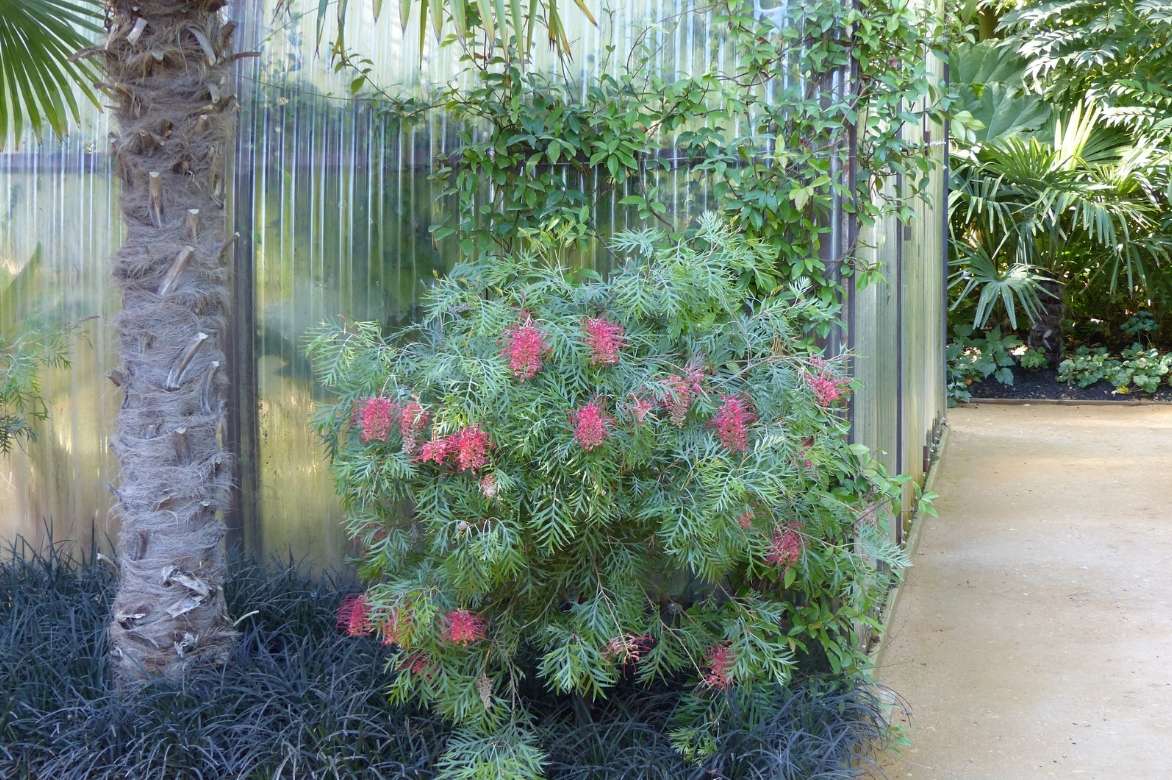
Grevillea ‘Robyn Gordon’ in situ
Pruning and care
Monitor watering during first summers to encourage establishment and vigour of the young plant. Avoid overwatering; soil should dry out to about 1 cm depth between waterings. Avoid using hard water, which causes yellowing of leaves.
Cover the young plant with winter fleece to protect from cold if needed, but above all from excess water at root level.
In poor soil, it is advisable in autumn to mulch the base of Grevillea with debris to a depth of 8–10 cm (dead leaves, shredded branches, grass clippings). The plant thus produces a dense superficial root-hair system capable of capturing the maximum of minerals and water contained in the humus.
In a pot, fertilise with a low-phosphorus (P) fertiliser such as 18-2-10 so as not to reduce its flowering. Take care not to subject it to severe drought stress, which can kill it suddenly, while ensuring water does not stagnate in the saucer. During winter let soil dry out to about half the pot’s height (a terracotta pot allows visualisation of moisture level). Repot in spring, especially early on; afterwards simply renew surface soil of the pot.
Pruning of Grevillea
Reduce shoots by one-third of their length after flowering or during their growth period if you wish to keep the young plant more compact.
Possible diseases
Grevillea are rarely affected by disease apart from shoots that sometimes dry out or become covered with black spots following fungal attack. Promptly prune dead shoots, open up base of bush (which must not be buried) and protect it from excess moisture. Apply a copper-based fungicidal treatment to spotted foliage.
Phytophtora cinnamonii, which affects many Australian and native plants, thrives during wet winters by blocking sap-conducting vessels. When the first warm weather arrives the bush suddenly withers partly or entirely. Soil drenching with a systemic fungicide such as Aliette helps reduce its impact.
Yellowing of foliage is often due to excess lime in soil or in irrigation water.

Multiplication
Multiplication of Grevillea is fairly complicated, both propagation by cuttings and sowing. You can try sowing after scarifying seeds or by separating suckers when plant is suckering.
Sowing
- Scarify seeds with sandpaper or soak seeds in water for 24 hours.
- Sow them in a seed tray or alveolates filled with sowing compost moistened the day before. Cover with a thin layer of vermiculite and place in indirect light.
- Place in a mini greenhouse kept between 10 and 15 °C, in indirect light from the sun until seeds germinate.
- Prick out into buckets as soon as you can handle seedlings without disturbing roots too much.
Uses and associations
In an exotic or Mediterranean garden on neutral to acidic soil, it can be included in a large rockery of structural plants reaching skyward such as Agave, Beschorneria, Aloe, Cordyline australis, Canary viper’s bugloss (Echium pininana), palms, paired with massive forms such as Euphorbia mellifera, Protea, evergreen ceanothus, Melianthus major, Euryops, Callistemon and Leptospermum. The creeping form Mount Tamboritha can carpet the foreground rocks while other Grevillea species are better placed at the back of the bed or at the top of the bank.
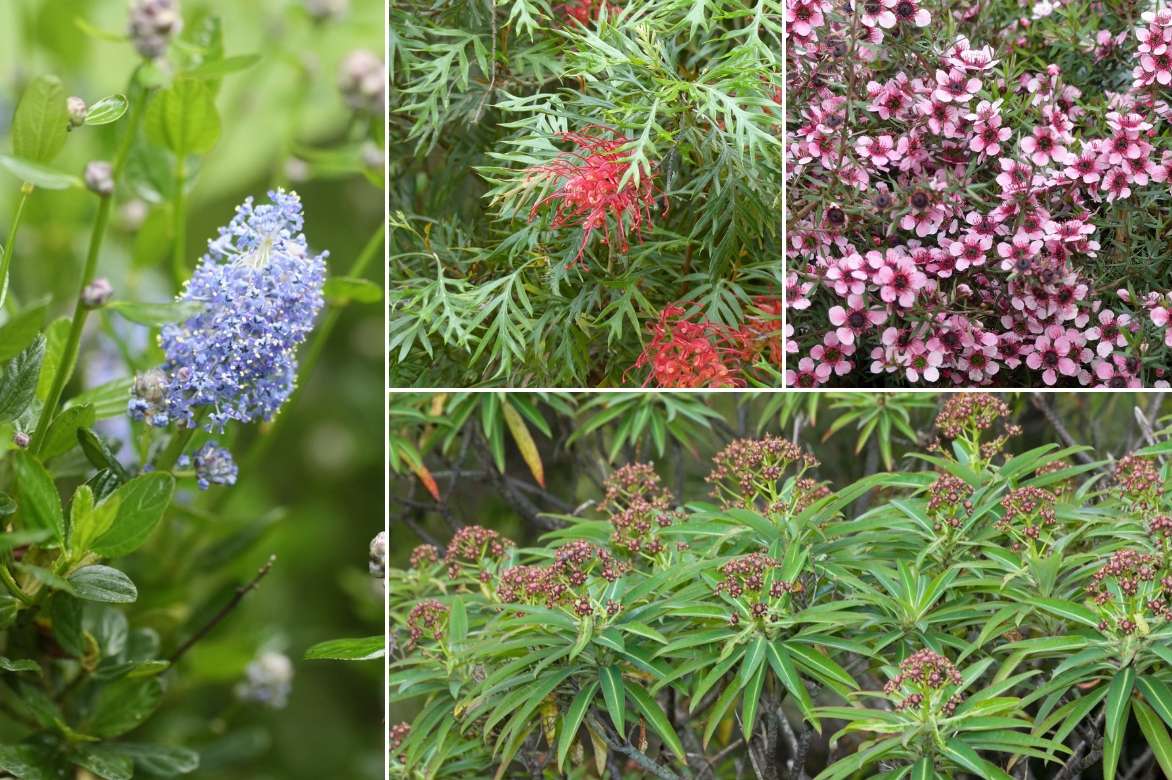
An example of a planting combination: Ceanothus ‘Skylark’, Grevillea ‘Robyn Gordon’, Leptospermum scoparium ‘Martini’, Euphorbia mellifera (photo H.U. Küenle)
Grevillea generally form masses of tangled, rather prickly branches that can create impassable hedges, flowering for a very long period, within 3–4 years. This sun-loving plant, hardy and tolerant of sea spray and requiring fairly poor soil, grows perfectly by the sea.
In containers, pair it with Mediterranean plants such as Cassia florinbunda, Cape Plumbago, Leptospermum, Caesalpinia gilliesii, Sesbania punicea, palms and citrus trees which you will bring into a cool greenhouse or a very bright, lightly heated conservatory over winter.
Frequently asked questions
-
My Grevillea is turning yellow — is it going to die?
Excess lime in soil causes chlorosis of foliage, i.e. yellowing of laminae and weakening of plant, which can no longer carry out effective photosynthesis. Easiest is to water with rainwater and mulch with blond turf or pine needles to maintain soil acidity.
- Subscribe!
- Contents
































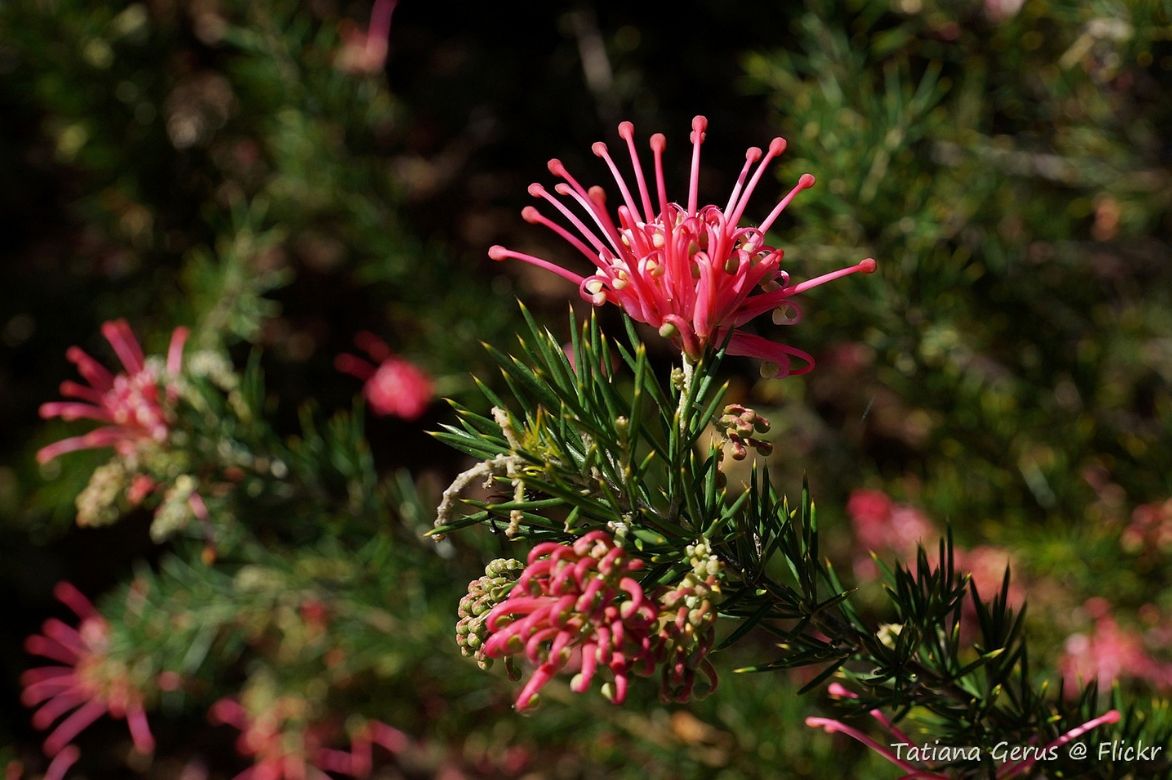









Comments